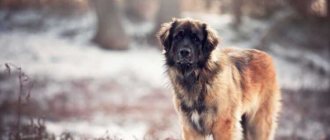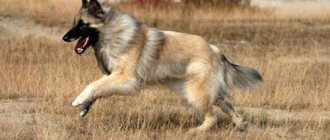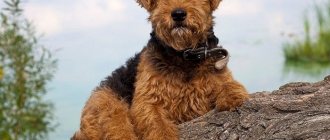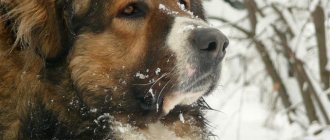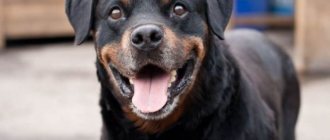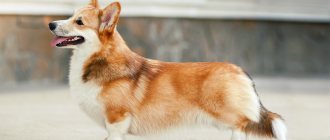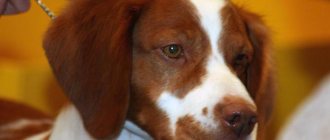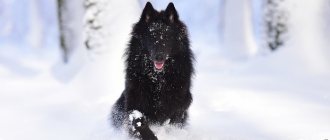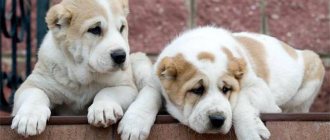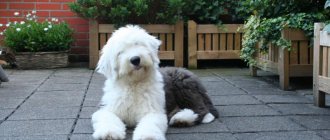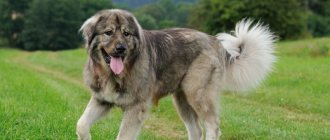In the modern world there are a large number of dog breeds for every taste. Some people like big dogs, while others like miniature pets.
Small breeds are suitable for keeping in an apartment, but if you need a protector and a loyal friend, it is better to pay attention to large breeds.
One of the ancient breeds is the Caucasian Shepherd Dog or Wolfhound. This breed appeared in the Caucasus more than two thousand years ago.
Description of the appearance of the Caucasian Shepherd breed
The Caucasian Wolfhound or Caucasian Shepherd Dog is of average height.
- An adult male can reach 75 cm in height, while females are slightly lower, up to 70 cm.
- Weight ranges from 51 to 69-70 kg.
- Some individuals can gain weight up to 100-110 kg.
The photo of the Caucasian Shepherd clearly shows how thick the hair of its representatives is. The color can be different - wolf-gray, brown, fawn, red and even pure white.
Characteristic is a contrasting mask on the face, most often black. The most popular varieties are: Armenian, Georgian and Azerbaijani. They differ from each other in size, thickness and length of fur.
According to the current FCI standard (last changes dated 03/02/2011), the following main appearance characteristics apply in the description of the Caucasian Shepherd breed:
- The body is muscular and sinewy, the body is massive, well developed;
- The head is quite wide and wedge-shaped;
- Jaw with a straight or scissor bite, teeth white and even (42 pieces);
- The eyes are small, deep-set, their color is characterized by various shades of brown;
- The tail is long, curled in the form of a ring/sickle
- The limbs are muscular, the front and rear are parallel to each other and set wide apart;
Distinctive features
The Caucasian Shepherd Dog is recognized by the FCI and is included in group 2/section 2. Molossians (2.2. Mountain dogs). Large dogs with a powerful, muscular croup are perfectly adapted to the climatic conditions of the region. They are ideal assistants to shepherds on pastures and are famous for their unsurpassed guard qualities.
Basic exterior data:
- The head is massive, heavy, wedge-shaped.
- The skull is wide, the frontal part is flat, there is a fold.
- The ears are hanging, short, set above the eye line, triangular in shape, often cropped.
- The eyes are small, oval in shape, dark in color, most often brown.
- The eyelids are dry and black.
- The cheekbones are large.
- The stop is not pronounced, the transition is smooth.
- The muzzle is shorter than the forehead, not pointed.
- The nose is wide. The nose is voluminous and black; in light-colored dogs it can be brown.
- The lips are thick, dry, and fit tightly.
- bite . The jaws are strong. The teeth are white, very large, strong, a complete set of 42 teeth - 22 on the lower jaw and 20 on the upper jaw.
- The croup creates an almost horizontal line, wide and muscular.
- The bones are large.
- The skin is thick and elastic.
- The neck is short, wide, powerful.
- The chest is wide.
- The withers are well visualized and wide.
- The back is clearly muscled, straight and wide.
- The loin is slightly convex.
- Limbs straight, parallel; The hind limbs have significant fur.
- The hock joints are strong and wide.
- The paws are compressed, massive, oval in shape.
- The gait is a slow trot.
- The tail is long, set high, and completely covered with hair. In its natural state - in the form of a sickle, hook or ring. Cupping is allowed.
- Color: gray, red, white, brindle, piebald, fawn, spotted, light and reddish shades are allowed.
- The coat is straight, thick, coarse, with a light-colored undercoat; The length of the coat is 6-7 cm for short-haired dogs and 10-12 cm for long-haired dogs, slightly shorter on the head and limbs, and fits tightly to parts of the body.
History of the origin of the breed
Since ancient times, dogs have served people with great devotion. The Caucasian Mountain Shepherd is a fairly ancient species, whose history dates back thousands of years. It owes its origin to the herding breeds of antiquity.
There are several versions of the origin of this species - according to one of them, the dog first appeared in the foothills of the Caucasus to protect pastures and livestock more than 2,500 years ago, the second version considers its Tibetan origin from the so-called breed of Tibetan pickling dogs, which were used for dog fighting. Neither of these versions has official confirmation, but both of them are quite plausible.
- Mention of the appearance of the predator in Russia begins with the post-war period of the Caucasian War.
- Since 1765, according to an official document, the owners of these dogs were involved in guard duty.
- From the beginning of the 20th century, breeding work with this species began, which was interrupted by the beginning of the Great Patriotic War.
Since the end of the century, the eyes of breeders and scientists have again turned to this breed, because its ideal guarding qualities will always be in demand.
Development of the breed in the USSR
Despite the successful use of these large dogs for the needs of the Red Army, breeding work with them was practically not carried out until 1930. Moreover, until this year, no trouble was seen in matings between the Northern Administrative District and the “Caucasians”, classifying them as a single group of aboriginal “Asians” .
Everything changed after the IV All-Union Service Dog Exhibition, where, according to the final results, the “Caucasians” received the best marks, collecting 15 top awards out of 36 allocated to this group.
After such success, it was decided to define the KO as a separate breed, give it status and carry out pure breeding.
A primary breed standard was developed: “Caucasian Shepherd Dog. Exterior and characteristics of the breed", which was adopted in 1931 and became the first standard for CR.
Longhaired Caucasian Shepherd
Intra-breed types were also included in the standard in order to exclude misinterpretation of the external data of animals by judges and to outline a unified approach to their assessments in the rings.
The Georgian Nagazi was chosen as the desired type that all breeders should strive for from now on. Since at that time breeding work was mainly carried out by departmental nurseries, no one challenged this decision.
After 1931, several scientific expeditions were made to the Caucasus regions in order to remove dogs of the desired type (according to the standard) and carry out canine work on the formation of the breed (according to the breeding plan).
All selected dogs received the status of “unknown origin” and were sent to various nurseries, where they became the founders of new breeding lines.
The first nursery to receive KOs of the desired type was the Central Educational and Experimental Nursery (TsUOP), founded in 1924 (now called Krasnaya Zvezda).
The kennel already had German, South Russian and Central Asian shepherd dogs on its base.
After 1931, “Caucasians” also appeared there.
The task of the kennel specialists was not easy - it was necessary to give the new breed its own individually distinctive characteristics and clearly assign them to the descendants, without losing the valuable qualities inherent in the entire group of Asian Shepherds. And they coped with this task!
In 1936, in Nuremberg, OSOAVIAKHIM (predecessor of DOSAAF), demonstrated territorial dogs of Soviet Russia, among which were 3 KOs belonging to the Central Training and Experimental Kennel. Two males received an “excellent” rating, a female received a “very good” rating. good.”, and even then, most likely because females do not look as impressive as males.
Caucasian Shepherd with medium length coat
During the war years from 41st to 45th TsUOP and other breeding nurseries lost most of their livestock, although they tried to preserve the most outstanding representatives by exporting them to distant areas.
After the war, one could only cry over the remaining “handful” of Caucasian Shepherd dogs - there were so few of them left. The question even arose about the profitability of further breeding.
The issue was resolved in favor of KO, and work on the restoration, further breeding and popularization of the Caucasian Shepherd breed was entrusted to the Central Military-Technical School of Dog Breeding (as the Central Military-Technical School of Dog Breeding was called after June 24, 1941) and the Ministry of Public Utilities of the RSFSR.
In the fall of 1971, at the World Dog Show in Budapest, where animals from 50 countries took part, restored KOs were exhibited.
Almost all the dogs received high marks, and the pair Uran and Zurna brought the title “Winners of the Exhibition” to the USSR. After the rapid victory of the Soviet giants, the standard (adopted back in 1931) was slightly changed in accordance with the data of the winners.
The updated KO standard was adopted in 1976 and was subsequently (1982) supplemented with stricter requirements for the dental system.
And already at the All-Union Exhibition of Domestic Working Dog Breeds (1988), the updated Caucasian guard dogs clearly prevailed over other domestic breeds, including such a recognized leader as VEO.
Characteristics of the Caucasian Wolfhound
One of the most valuable characteristics of the Caucasian Shepherd can rightfully be considered devotion to its owner and territory. This is most likely due to the fact that for a long time she, in the company of one shepherd, guarded the herd or territory entrusted to her.
- The Caucasian is very balanced in his interactions with all family members, including children, for whom he will become an excellent nanny.
- When playing with children, it can allow them a lot. Tolerant of other pets and will consider them as her charges, as well as the territory entrusted to her
- The dog's apparent slowness is extremely deceptive. They have a lightning-fast reaction, which does not fit into the image of such a clumsy animal.
- The Caucasian Shepherd has a very delicate hearing and sense of smell, so violators of the protected area have no chance of passing unnoticed, even when the dog is sleeping.
Caucasians are smart, amenable to proper training and are endlessly devoted to their owners. They endure separation from them very hard and are very sad.
A stranger will never be able to achieve her favor, which is why there is a strong opinion about the dog’s waywardness. This is not surprising, because you can feel the full extent of a dog’s love and devotion only by being its owner.
Application
Most often, those who want a true friend and devoted protector want to buy a Caucasian Shepherd.
This is an ideal security guard for your own home, which is more convenient to live on the street.
Caucasian Shepherd Dogs that meet the standard often take part in exhibitions and are popular due to their size, long coat and interesting color variations.
A dog of this breed becomes very attached to its owner, and it is extremely difficult to tolerate even short-term separations.
At the same time, she needs an owner with a strong-willed character.
Female Caucasian Shepherd Dogs are more flexible and easier to train, males are more capricious, strong, impressive, they need a confident and experienced owner
Training and education of the Caucasian wolfhound
Any good dog can be ruined. Regarding Caucasians, these are not empty words, but a harsh reality. Moreover, the process of education begins immediately from the moment you brought her home.
The owner of a furball is recommended to show sufficient firmness, and sometimes even harshness, when communicating with a Caucasian. If a person does not show his authority and cannot help her adapt to society, then she may grow into an absolutely uncontrollable beast, which, most likely, will have to be sent back to the nursery.
- The training process should be approached with the understanding that it will last not one year, but at least two, because a dog of this breed slowly matures - up to two years. There is no specific method for training a Caucasian, but, guided by general principles, you can achieve good results.
- By 5-6 months, you need to start teaching your dog simple commands: “Ugh!” or “You can’t!”, “Come to me!”, “Nearby!” or “Place!”, “Sit!” and “Lie down.”
If the owner shows due patience in the learning and training process, without unnecessary cruelty and aggression, and puts in maximum effort and patience, he will end up with an excellent friend and an excellent guard. The most important thing is personal contact with the Caucasian; it is very important to conduct all training personally, because the dog is loyal to one owner.
Mating
Puberty occurs slowly in large breeds.
- The first heat in a Caucasian Shepherd bitch is recorded at the age of 5-6 months , after the appearance of molars, sometimes accompanied by molting. It often goes unnoticed, so owners need to carefully monitor the dog’s behavior. The main sign of heat is aggression towards male dogs.
- It is recommended to note the dates of the first and subsequent heats in a separate notebook, since females are ready for mating after the third heat. This usually occurs towards the end of the dog's second year of life. It is not advisable to carry out mating earlier. This can negatively affect both the health of the dog itself and the health of its offspring.
- Sex hormones in Caucasian Shepherd dogs begin to be produced by 6 months. However, knitting them before 2 years is also not recommended.
- Mating takes place on the 10th day after the start of estrus and takes place in the male dog’s territory. When making a pair, it is necessary to observe the hierarchical principle and take into account the sign of dominance. This is especially important during the first mating. The rule is that the “experienced” partner should dominate the “inexperienced” one.
Given the aggressive nature of the Caucasian Shepherd, a muzzle is often put on the bitch when mating. In any case, the mating site should be deserted, the possibility of strangers appearing should be minimized.
Nutrition and care of the Caucasian Shepherd
Despite the impressive size of the dog, its diet is quite small. Of course, it is necessary to control and diversify the menu.
The calculation is made as follows:
- 30-45 grams of natural food per kilogram of animal weight and approximately
- 10-20 grams of dry food is proportional to a kilogram of weight.
The diet is varied - any meat, cereals, preferably buckwheat and rice, less often fish. Feeding with vegetables and fruits is allowed. The dog is not spoiled when it comes to food, apparently due to the meager diet of its ancestors, who sometimes lived in extreme natural conditions. Don't forget to give your dog water - the more often the better.
Ideally, it is better to get a Caucasian wolfhound for those who have their own house with a plot. Then the animal will be able to build a spacious enclosure with a booth. But, if you take a dog into an apartment, then it will have to free up a lot of space, because it is quite large.
- Regarding hygiene. An adult must be washed at least once a week or when dirty.
- Its coat needs careful combing, especially during the molting period. During the warm period, it is better to prevent the possible appearance of ear mites.
Don’t forget to let your Caucasian chew on bones or wooden planks to clean his teeth of food debris.
It is very important to accustom her to wearing a muzzle and a leash. A walk should definitely be part of your pet’s daily routine. If the dog lives in his own house, then it will be enough to take him out at least once a day. If this is an apartment in an urban area, then it is better to walk several times a day
Key points in training
The stubborn, self-sufficient nature of the Caucasian Shepherd dictates the peculiarities of its training. The main qualities that a dog owner must have are willpower, perseverance, inflexibility and strong character. The dog obeys only unconditional authority and leader.
Training a Caucasian Shepherd should begin from the moment it appears in the house. Key points of training:
- establish rules of behavior and clear prohibitions;
- do not use physical force;
- do not raise your voice;
- do not rush the dog in the process of teaching commands;
- take a course of OKD and subsequently CS;
- accustom to a muzzle.
In the absence of experience, it is not recommended to train yourself. Caucasian Shepherds are intelligent and have a high level of intelligence. Learning and consolidation of skills occurs quite quickly. Therefore, an inexperienced owner may unknowingly “teach” the dog unwanted behavior.
It must be remembered that the most important period in the development of the psyche and physiology of an animal is the age of up to 9 months. The pet must complete basic training courses at this stage. Correcting mistakes made in raising a puppy is often beyond the power of even experienced dog handlers.
Read about how to properly train a dog in the article: “Training a puppy: effective methods from dog handlers, learning commands at home.”
Diseases and their treatment
The immunity of representatives of this breed is quite high. The breeders did not observe any serious deviations in health. Among the most serious and common diseases are problems with the hip joint.
There are individuals with diabetes mellitus, but this may be due to a sedentary lifestyle. With a proper diet and daily walking, this problem will not arise.
It is important to carry out the entire range of vaccination activities. Do not forget that the best protection for yourself and your pets from any infection is its vaccination prevention.
Coat and color of the breed
Shepherds' coat is dense and dense. It helps dogs cope with all harsh climatic conditions. Their wool consists of three parts and helps to survive both rain and snowfall. Under the long hair of the top layer there is a dense awn and a soft undercoat. Each of these layers can be predominant, so there are 3 more types of shepherd dogs: long-haired, intermediate and short-haired. The coat color is predominantly dark shades. White Shepherds are very rare. Mostly grey, black and brown tones predominate.
Caucasian wolfhound crossbreeds
Mixing of any large breed with the Caucasian Shepherd is allowed. The most popular are crosses with German shepherds, huskies, St. Bernards, and huskies.
The most popular type of Caucasian Shepherd crossbreed is the Alabai. This mixture takes the best character traits from its parents and becomes excellent guards, who have practically no equal among their relatives.
Cost of a Caucasian Shepherd puppy
It is best to purchase a Caucasian wolfhound from a specialized nursery. After all, it is there that you can get primary information about her - the degree of possible aggressiveness of the parents, the presence of a pedigree, veterinary documents.
- The price of a Caucasian Shepherd starts from 25,000 rubles.
- If you need a premium class individual with further promotion to various exhibitions, the price for such a puppy can start from 45,000-50,000 rubles.
Choosing a puppy - what to look for
Caucasian Shepherd puppies look very similar to clumsy bear cubs. They can be called rather plump, even well-fed. The paws are quite massive even at an early age. The look is wary, very attentive. The puppy may have cropped ears.
- An important aspect is to observe the puppy's behavior.
- If he shows strong leadership qualities when communicating with brothers and sisters, then the likelihood of getting a serious individual as a companion increases.
- Of course, you shouldn’t choose an absolute melancholic either.
- It is much more logical to choose someone who behaves absolutely adequately for a given age and is equally active compared to his relatives.
If we summarize all of the above, then we can quite clearly understand that any pet requires due attention and patience from its owners. The Caucasian wolfhound will require special attention and patience from you.
Of course, they are capricious, in some places even aggressive and dangerous, but all this is an outer shell, for outsiders. For her owner, she will always remain an excellent guard and a very loyal and devoted friend.
The main thing is to understand that raising a pet is a responsibility not only to him, but also to those who live next to us.
